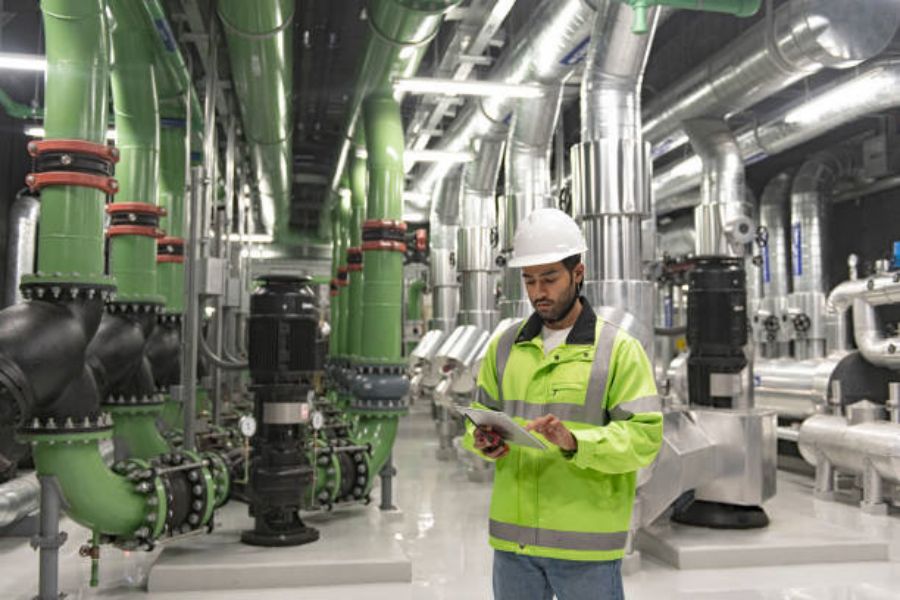Introduction
Heating and cooling systems play crucial roles in regulating the temperature of indoor spaces throughout the year. There are various types of HVAC systems available on the market today, and one such system is a chilled water system. In this article, we will explore the different aspects of a chilled water system, its features, advantages, and disadvantages.
What is a Chilled Water System?
A chilled water system is a central air conditioning system that uses water as a cooling medium instead of refrigerant. It consists of a network of pipes that carries chilled water from the chiller to the air handling units (AHUs) located within a building. The chilled water is then used to cool the air and dehumidify it before being distributed to the indoor spaces via ductwork.
Components of a Chilled Water System
A typical chilled water system comprises various components, including a chiller, cooling tower, pump, air handling unit, chilled water piping, and control system. The chiller is the heart of the system, which cools the water to the desired temperature using a refrigerant. The cooling tower is responsible for removing excess heat from the water and releasing it into the atmosphere. The pump is used to circulate water throughout the system, while the air handling unit is responsible for conditioning the air.
Advantages of a Chilled Water System
Chilled water systems have several advantages over traditional air-cooled systems. Firstly, they provide better air quality since they do not re-circulate air or introduce outside air pollutants into the indoor space. Secondly, they can be easily scaled to accommodate changes in cooling load. Thirdly, they are quieter and more efficient than traditional systems since they do not require a large compressor. Lastly, they can be configured to provide both cooling and heating, eliminating the need for separate HVAC systems.
Disadvantages of a Chilled Water System
Despite its numerous benefits, a chilled water system has a few downsides. The primary disadvantage is its high installation cost, making it unsuitable for small spaces or budget-conscious homeowners. It requires a significant investment in infrastructure, including piping, chiller, cooling tower, and air handling units. Secondly, it requires periodic maintenance to ensure optimal performance, as well as skilled personnel to operate and repair the system. Lastly, if not correctly maintained, it can become a breeding ground for bacteria and mold, posing a health hazard to the building occupants.
Applications of Chilled Water Systems
Chilled water systems are widely used in commercial, industrial, and institutional buildings, such as hospitals, offices, data centers, and universities. They are preferred in these applications due to their precision cooling, lower noise levels, and improved indoor air quality. However, they are not commonly used in residential applications due to their high cost and complexity.
Types of Chilled Water Systems
There are two types of chilled water systems: air-cooled and water-cooled. Air-cooled chiller systems use air as a cooling medium, while water-cooled systems use water. Air-cooled systems are typically smaller, less expensive, and require less maintenance, making them ideal for smaller residential and commercial spaces. On the other hand, water-cooled systems are more efficient and suitable for larger commercial and industrial applications.
Energy Efficiency of Chilled Water Systems
Chilled water systems are highly energy-efficient and can save up to 50% of energy compared to traditional air-cooled systems. They achieve high energy efficiency by operating at lower temperatures, reducing the load on the compressor and reducing the workload on the entire system. Additionally, they can be equipped with variable frequency drives (VFD) to optimize energy savings and control cooling capacity.
Maintenance of Chilled Water Systems
Proper maintenance of chilled water systems is essential to ensure optimal performance, reliability, and longevity. Maintenance tasks include regular cleaning of the chiller and cooling tower, replacing worn-out parts, checking for leaks, and ensuring proper water chemistry to prevent corrosion and deposition. The frequency of maintenance depends on the size of the system, the usage load, and the operating conditions.
Conclusion
A chilled water system is an efficient, cost-effective, and reliable way to cool large indoor spaces. It offers many advantages over traditional air-cooled systems, including quiet operation, improved indoor air quality, and better energy efficiency. However, it requires a significant investment in installation and maintenance, making it unsuitable for small spaces or residential applications. Proper maintenance is crucial to ensure optimal performance and mitigate the risks of bacterial growth and mold infestation.
